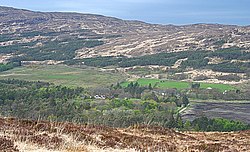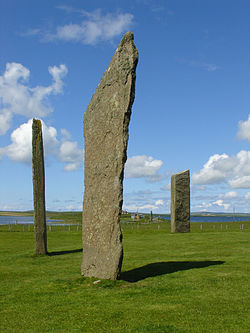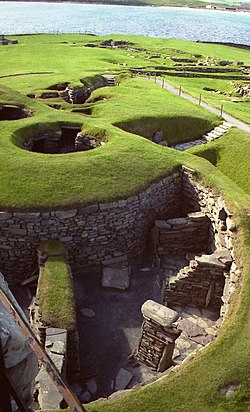| History of Scotland |
|---|
 |

This timeline of prehistoric Scotland is a chronologically ordered list of important archaeological sites in Scotland and of major events affecting Scotland's human inhabitants and culture during the prehistoric period. The period of prehistory prior to occupation by the genus Homo is part of the geology of Scotland. Prehistory in Scotland ends with the arrival of the Romans in southern Scotland in the 1st century AD and the beginning of written records. [1] The archaeological sites and events listed are the earliest examples or among the most notable of their type.
Contents
- Timeline
- Palaeolithic
- Mesolithic
- Neolithic
- Bronze and Iron Ages
- Sites of uncertain date
- See also
- References and footnotes
- External links
No traces have yet been found of either a Neanderthal presence or of Homo sapiens during the Pleistocene interglacials, the first indications of humans in Scotland occurring only after the ice retreated in the 11th millennium BC. Since that time, the landscape of Scotland has been altered dramatically by both human and natural forces. [2] Initially, sea levels were lower than at present due to the large volume of ice that remained. This meant that the Orkney archipelago and many of the Inner Hebridean islands were attached to the mainland, as was the present-day island of Great Britain to Continental Europe. Much of the present-day North Sea was also dry land until after 4000 BC. Dogger Bank, for example was part of a large peninsula connected to the European continent. This would have made travel to western and northern Scotland relatively easy for early human settlers. The subsequent isostatic rise of land makes estimating post-glacial coastlines a complex task and there are numerous raised beaches around Scotland's coastline. [3] [4]
Many of the sites are located in the Highlands and Islands. This may be because of the relatively sparse modern populations and consequent lack of disturbance. Much of the area also has a thick covering of peat that preserves stone fragments, although the associated acidic conditions tend to dissolve organic materials. [5] There are also numerous important remains in the Orkney archipelago, where sand and arable land predominate. [6] Local tradition hints at both a fear and veneration of these ancient structures that may have helped to preserve their integrity. [7]
Differentiating the various periods of human history involved is a complex task. The Paleolithic lasted until the retreat of the ice, the Mesolithic until the adoption of farming and the Neolithic until metalworking commenced. [8] These events may have begun at different times in different parts of the country. A number of the sites span very long periods of time and in particular, the distinctions between the Neolithic and the later periods are not clear cut. [9]














